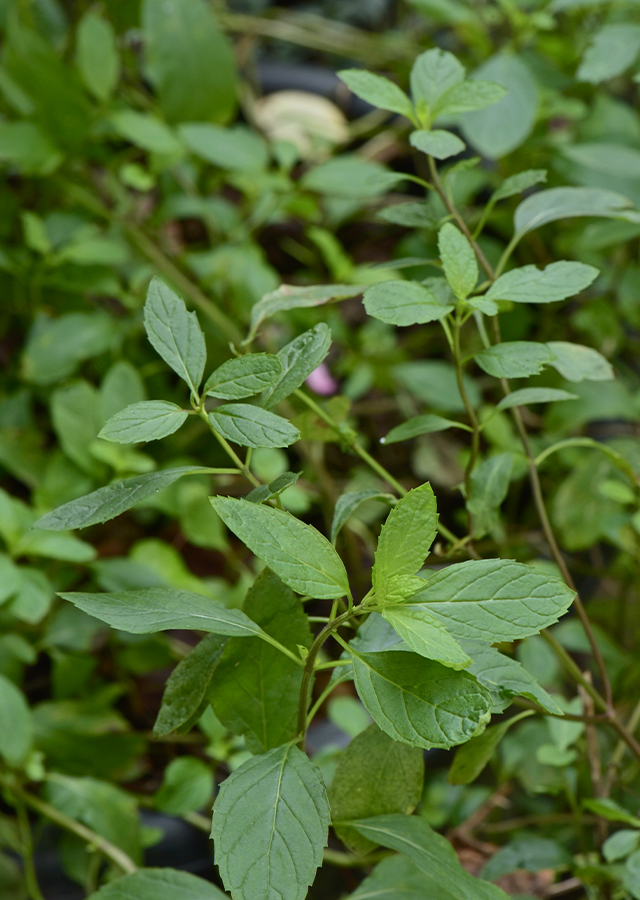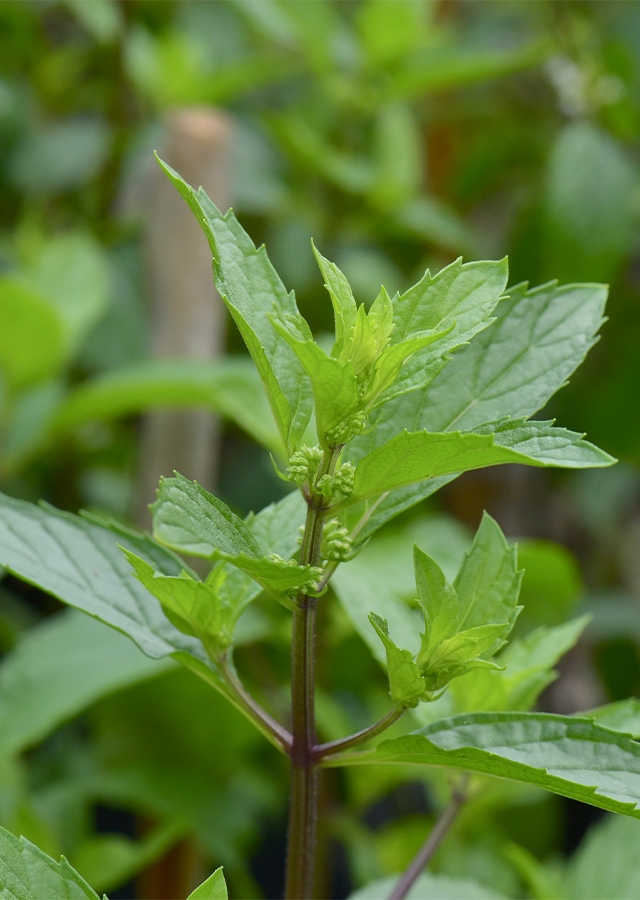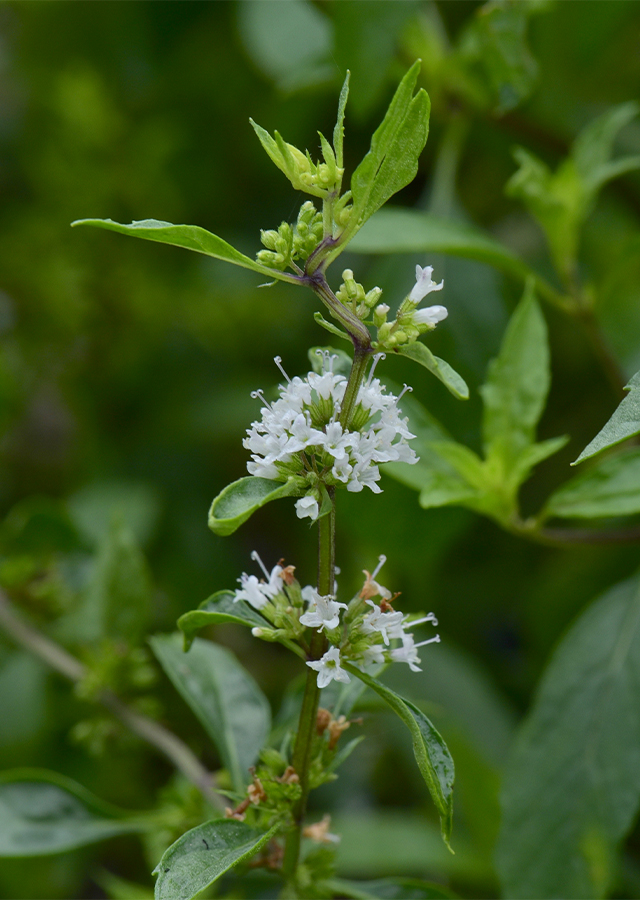Wild mint
Mentha arvensis L.
Lamiaceae
Location in our garden
Principal



Synonym
Calamintha arvensis (L.) Garsault
Mentha agrestis Sole
Mentha agrestis Hegetschw.
Habitus
Herbaceous. An erect herbacious, perennial herb, can grow up to 45 cm tall.
Part Used
Leaves
Growing Requirements
Full Sunshine
Need Shade
Habitat
Forest
Shrublands
Overview
Mentha arvensis is native of Japan, is cultivated extensively in the temperate regions of Western, Europe, Central Asia, East to the Himalaya and Eastern Siberia. Other literature mentions Mentha native from Europe and Central Asia. It is useful plant and used as condiment, source of essential oil, household remedy, and industrial purposes. It has been mainly used to flavour food and for medicinal purposes. The whole plant has a very strong mint scent.
Vernacular Names
Mensa arubenshisu (Japanese), Menta selvatica (Italian), Yerbabuena (Phillipines), Po-ho (Chinese), Ackerminze (German), Hilbas (Thailand),Pudinah (Hindi, Persian), Hortelã-comum (Portuguese), Menta japonesa (Spanish).
Agroecology
It succeeds grow best under cool conditions, most soils, humid localities and situations so long as the soil is not too dry. It tolerates much drier conditions than other members of the genus. Prefers a slightly acid soil, in heavy clay soils. Mints grow best in deep soils rich in humus, with a pH of 6-7.5. A sunny position is best for production of essential oils, its also grows in partial shade.
Morphology
- Stem - prostrate, stoloniferous, pubescent with appressed hairs, cylindrical, much-branched, and ultimate ascending terminal branches.
- Leaves - elliptic to oblong-ovate, lanceolate to broadly lanceolate, 1.5 to 4 centimeters long, acute at apex, short-stalked with toothed margins, and rounded or blunt tipped, membranaceous, stipules absent, strongly aromatic herb.
- Flowers - bisexual, hairy and purplish to bluish, borne in axillary head-like whorls. Corolla funnel-shape and hairy, Calyx tubular-campanulate and pressed hairy.
- Fruit - nutlets ellipsoid, finely granular, about 1 mm long, often pointed at apex.
Cultivation
- Generative propagation is by seed. Without hybridisation, seedlings will not be uniform and so the content of medicinal oils will vary.
- Vegetative propagation is by division, can be easily carried out at almost any time of the year. Virtually any part of the root is capable of growing into a new plant. For maximum increase it is possible to divide the roots up into sections no more than 3 cm long.
Chemical Constituents
Menthol, menthone, methyl acetate, phenolic,piperitone, g-terpinene, α-terpineol, pipertone, menthofuran pinene, carvacrol, α-pinene, α-phellandrene, isomenthol, linalool menthofuran, b-myrcene, germacrene-D, pulegone, sabinene.
Traditional Medicinal Uses
- The antimicrobial activity of essential oil sample extracted from wild mintwas evaluated against Salmonella spp., E. coli, Campylobacter jejuni.
- It used in hypertension and in patients with ischemic heart disease. The oilcontent of leaves is antiseptic, carminative, refrigerant, stimulant and diuretic in properties, and is used against skin infections.
- Leaves, whole plants and the oil extracted from M. arvensis are used as acarminative, stomachic, antispasmodic, stimulant, sedative, sudorific,emmenagogue, astringent (externally) and refrigerant (externally).
- They are administered internally to treat indigestion, flatulence, gastro-intestinal atony, colic and diarrhoea, or externally in the treatment of colds,influenza, fever, sinusitis, nose and throat complaints (all e.g. as nasaldrops), headache, facial neuralgia and insect stings (e.g. as rubefacient)
- American Indians used the leaves to prepare medicine for kidney diseases.
- In Indonesia, pounded leaves are used externally against headache, and an infusion of the leaves as sudorific and expectorant to treat cough, as acarminative, and as antispasmodic in gastro-enteritis.
- In Nepal, tea made from leaves and flowers is an excellent remedy for treatment of flatulence, indigestion and nausea.
Part Used
Reference Sources
- Singh, S. (2017). Ethnobotanical study of wild plants of Parsa district, Nepal. Ecoprint: An International Journal of Ecology, 24, 1-12.
- Thawkar, B. S. Jawakar A.B, kalamar, P.V, Pawar K.P, kale, M.K. (2016). Phytochemical and pharmacological review of Mentha arvensis. International Journal of Green Pharmacy (IJGP), 10(2): 71-76
- Verma, R. S., Rahman, L., Verma, R. K., Chauhan, A., Yadav, A. K., & Singh, A. (2010). Essential oil composition of menthol mint (Mentha arvensis) and peppermint (Mentha piperita) cultivars at different stages of plant growth from Kumaon region of Western Himalaya. Open Access Journal of Medicinal and Aromatic Plants, 1(1), 13-18.
- https://pfaf.org/user/Plant.aspx?LatinName=Mentha+arvensis
- https://uses.plantnet-project.org/en/Mentha_arvensis_(PROSEA)
